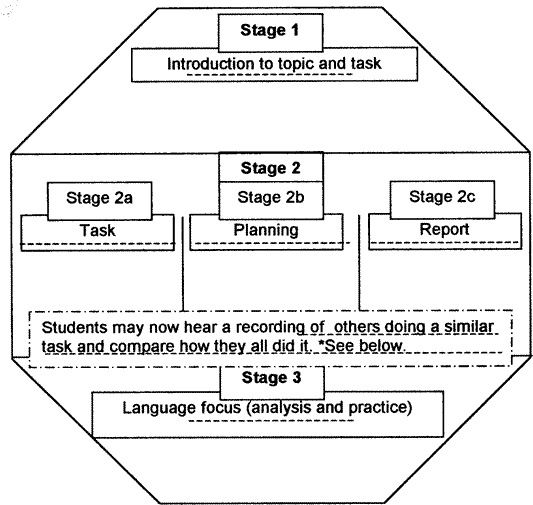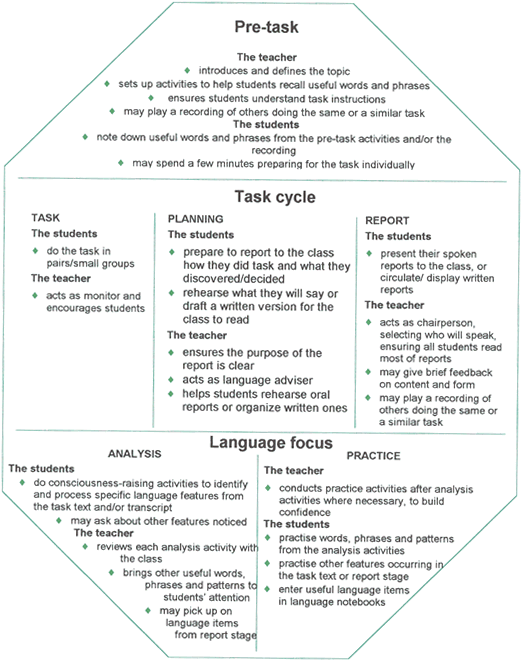Commentaries
Commentary
4.4.1
Commentary 4.4.2
Commentary 4.4.3
Commentary 4.4.4
Commentary 4.4.5
Commentary
4.4.6
Commentary 4.4.7
Commentary 4.4.8
Commentary 4.4.9a
Commentary 4.4.9b
Commentary 4.4.9c
Commentary 4.4.10

* Listening to a recording of fluent speakers doing the same or a similar task allows students to compare their findings and performance with those of more proficient speakers in terms of task achievement. It also provides feedback on the type of language fluent speakers used to complete the task. At this stage of the lesson, students are likely to be quite attentive to language form even if not directed to it, having just done planning and report activities when they were almost certainly consciously trying to improve their accuracy level. If the transcript of the recording will then provide the data for the language focus, this listening stage provides a seamless transition from task cycle to language focus. It could be considered both as a conclusion to the task cycle, and as an introduction to the language focus.
| Lesson stage number (see plan) | TBL stage |
| 1, 2, 3 | Pre-task |
| 4 | Task |
| (5), 6 | Planning |
| 7 | Report |
| (8), 9, 10, 11 | Language focus |
| 12 | Condensed task-plan-report all in one. |
Commentary
4.4.3
Suggestions for TBL teacher roles: facilitator; guide; monitor; evaluator;
timekeeper; language guide / adviser; motivator; organizer (of groupings,
classroom layout etc); operator of equipment (tape recorder etc); chairperson.
Commentary
4.4.4
Pre-task = setter of scene
task = encourager
planning = linguistic adviser
report = evaluator / giver of feedback.

| Task type | Report purpose: students can ... |
| Listing |
|
| Comparing |
|
| Ordering or sorting |
|
| Problem solving |
|
| Experience sharing |
|
| Creative |
|
Commentary
4.4.7
Here are some of the patterns that students might find, or that you might
point out to them if they get stuck. However, please note that this is
not intended as 'the answer'. Students may well have different criteria
for their classifications, e.g. all the phrases beginning with 'it' in
one group and all others in a second group. Alternative groupings are
just as valid as long as students can justify them, since it is the process
of 'playing around' with examples of language that is important, not the
linguistic outcome.
Group 1: Looks like + noun
(or to be precise, 'Looks (adv.) like + determiner + NOUN GROUP')
it looks rather like some sort of clothes peg
it looks like a clothes peg
something that looks vaguely like a hinge
It looks like the kind of thing that
Well it almost looks like a garlic press
Group 2: Looks like + verb
(or to be precise, '(It) looks (to me) like + subject +VERB')
Looks to me like you put a candle or something in that
Group 3: (It) looks as if / though + independent clause
It looks as though something could clip in
Looks as though that's meant to push something out
it looks as though you can actually ...
It looks as though it's meant …
it looks as if there is some kind of ... leverage principle involved
Group 4: it looks + adjective
It looks a bit technical
Group 5: Fixed phrase 'by the looks of it'
it's not supposed to stay shut, by the looks of it,
Group 6: Discourse marker 'look' to draw listener's attention to something
look that bit comes off
There's two of these, look.
Group 7: Verbal use: 'Can I look?
Can we look at it?
Group 8: As a noun in a verb phrase 'to have a (quick) look'
Can I have a quick look?
Concordance for 'look(s)'
phrases in the mystery objects task transcripts
(Note: a concordance is simply a list of lines of text arranged so that
the key word falls into line in a central column. Once sorted, eg into
alphabetic order of word immediately following the key word, patterns
can become much easier to see. Here, the phrases 'looks as if/though'
and 'looks like a' are made prominent by this technique. You can buy concordancing
software that will find and sort examples from large collections of texts,
but these aren't essential - for commonly occurring items, such as 'look'
in this collection of short texts, you or the students can do your own
manual concordances quite quickly.)
|
There's
two of these,
|
look. | |
|
Can I
have a quick
|
look? | |
|
Can we
|
look | at it? |
| look | that bit comes off | |
|
It
|
looks | a bit technical |
|
it
|
looks | as if there is some kind of leverage |
| ... | ||
|
It
|
looks | as though it's meant … |
|
It
|
looks | as though something could clip in |
| Looks | as though that's meant to push | |
|
it
|
looks | as though you can actually ... |
|
it
|
looks | like a clothes peg |
|
Well
it almost
|
looks | like a garlic press |
|
It
|
looks | like the kind of thing |
|
that
it's not supposed to stay shut, by the
|
looks | of it, |
|
it
|
looks | rather like some sort of clothes peg |
|
|
Looks | to me like you put a candle |
|
something
that
|
looks | vaguely like a hinge |
Commentary
4.4.9A
Here is my summary of the language features in my transcripts that I felt
were the more interesting ones that could potentially form the starting
point for CR work.
| WORDS, PARTS OF WORDS | ||
|
LOOKS |
SORT sort of + NOUN some sort of clothes peg a sort of wall the sort of, umm, the loop it's sort of an odd shape sort of + VERB it sort of opens it sort of fits sort of + ADJECTIVE it's sort of rather crude |
SOME... |
| KIND some + kind of + NOUN there is some kind of leverage some kind of washer |
||
| LIKE (note the overlap between this set and the 'looks' set above) looks (modifier) like + NOUN it looks rather like something that looks vaguely like it looks like the kind of thing it almost looks like a looks (…) like + SUBJ. +VERB Looks to me like you put Other (not)… anything like a door there's, like, some kind of a … Like, there's a hole |
IF Zero conditional if you press the end there... it moves up and down If you push that back it sort of opens the end you can push it, if you pull it this way if you put your fingers in there If you put that over the line … and slide it down ... It tightens it so it locks on the line First conditional what would happen if … if you put something into the loop VERB + as if it sort of fits as if … |
COULD/WOULD/MAY I think it could be something could fit it could be a big ring I'd say that's maybe it's |
| THEMES, NOTIONS AND FUNCTIONS | ||
|
MOVEMENT (OF PARTS) |
UNCERTAINTY Words and phrases which show the speaker is unsure or is being imprecise I think it could be It looks rather like it's a sort of a it looks as if there is some kind of it sort of opens a sort of wall or something you put a candle or something in something that looks vaguely like a hinge a hinge of some description it sort of fits That'd have to somehow go in there It's sort of rather … crude there's like, some kind of a, a washer If the screw goes through maybe then it umm will either stop it probably goes through the other way, doesn't it. it seems to spring back Possibly a candle or something Maybe it's some sort of storage container it could be something for a picnic that's a, a camping … thing for drinking out of, or whatever for cooking, possibly to fit them together perhaps maybe you're meant to slot something in a sort of an odd shape there's sort of ridged bits |
COMPARING Sentences and phrases that compare or relate one thing to another thing it looks like a clothes peg It looks like the kind of thing that ... would open a cupboard door it almost looks like a garlic press |
| CATEGORIES OF MEANING AND USE |
| Meaning: Find all the phrases containing the word 'sort' that describe an object. How many other examples of 'sort' did you find? What do they describe? |
|
Meaning: Study the concordance for the words 'look' and 'looks', and find all the lines for 'looks as if', 'looks as though' and 'looks like' (be careful to find them all - there might be an extra word between 'looks' and 'like'! There are ten altogether). Which of the three different phrases can describe
|
| Meaning: Find all the phrases with the word 'like' that compare one thing to another thing. What are the left over examples? |
| Use: Find the two phrases with the word 'something' that come after an object (noun). What word comes between the noun and 'something'? |
|
Use: Find all the examples of the word 'looks' which:
How many more examples
of the word 'looks' are there? Which of these belong with the 'looks
like' or 'looks as' group? Now how many are left? |
| Use: Find all the phrases that contain both the words 'looks' and 'like'. What words can come between 'looks' and 'like'? Did you find more examples with 'looks like' next to each other, or separated by one or more words? Which word most often comes before the word 'looks'? |
Commentary
4.4.10
My starting point was the notion of vagueness or uncertainty, realized
by language such as 'sort of', 'some kind of a', 'something that ...',
etc.
Activities 1 and 2 are transitional between the task cycle, in that they give students a chance to listen intensively to an extract from the tape that they have just heard as part of the follow-up to the report phase, and they also begin to focus attention onto the target language area. Activity 3 appears to be a fairly straightforward 'find all the examples' exercise, but note that there is no clear definition of what is to be found - students must first decide for themselves the nature of words and phrases they wrote down in exercise 2. So in this respect, activity 3 is already beginning to demand some analysis work of students. Activity 4 is a more straightforward classification exercise, but by no means easy, as there are many possible ways of sorting the large amount of data activity 3 will have generated. Activity 5 begins to direct students towards the patterns that their examples are found in - especially useful for examples like these that occur as semi-fixed phrases.